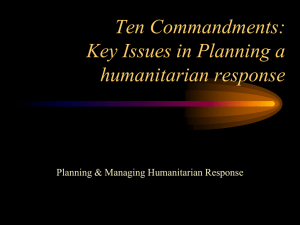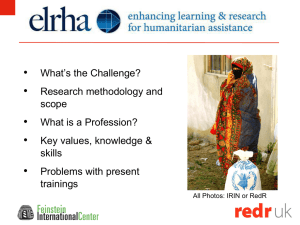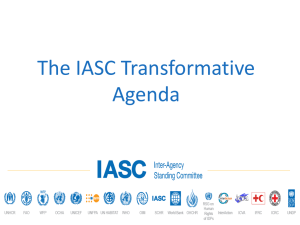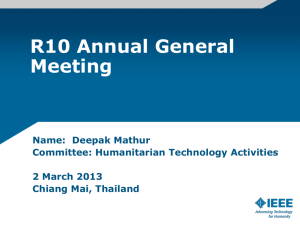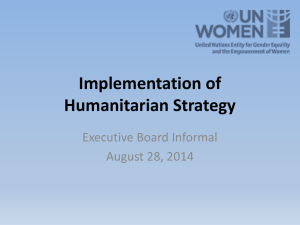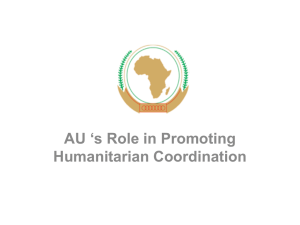OCHA Presentation HEI - The Graduate Institute, Geneva
advertisement
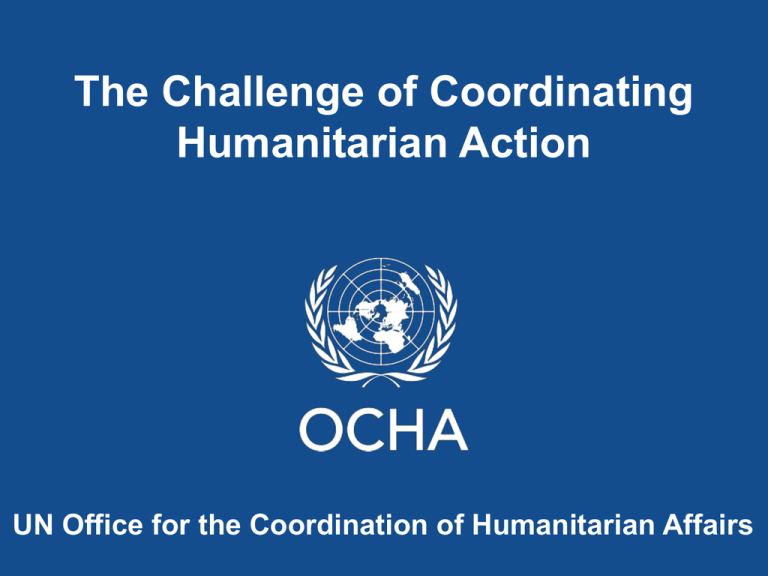
The Challenge of Coordinating Humanitarian Action UN Office for the Coordination of Humanitarian Affairs Humanitarian Assistance Humanitarian assistance is aid that seeks to save lives and alleviate suffering and maintain humanitarian dignity during and in the aftermath of man-made crises and natural disasters, as well as to strengthen preparedness for the occurrence of such situations... THE UN CHARTER PRINCIPLES FOR HUMANITARIAN ACTION UN CHARTER ARTICLE 1.3: “ … to achieve international cooperation in solving international problems of an economic, social, cultural or humanitarian character… UN CHARTER ARTICLE 1.4: … to be a centre for harmonizing the actions of nations...” A CHANGING CONTEXT IN A CHANGING WORLD DISASTERS ARE INCREASINGLY COMMON The number of disasters has almost doubled compared to two decades ago. Climate-related disasters account for 70% of all disasters, compared to 50% two decades ago. SOURCE: EM-DAT A CHANGING CONTEXT IN A CHANGING WORLD CONFLICTS ARE MORE COMMON LOW: Non-violent MEDIUM: At least one side using violent force in sporadic incidents HIGH: Violent force is repeatedly used by both sides in an organized way. SOURCE: HIIK A CHANGING CONTEXT IN A CHANGING WORLD Increased number of natural hazards provoking natural disasters. Fewer new wars, but more long standing complex conflicts. Fewer refugees, but more internally displaced persons. More actors who are engaging in humanitarian response. HUMANITARIAN PARTNERS Governments U.N. Agencies and programmes and International Organizations Humanitarian Coordinator (HC) NGOs (international & local) Civil society Red Cross/Red Crescent Movement Peacekeeping missions Donor Governments Private companies and individuals Military WHY DO WE NEED COORDINATION? To deal with a multiplicity of actors. To work with limited resources. To avoid the politicization of aid. To avoid gaps, duplications, and assure the responsibility of each humanitarian partner. OCHA’S MANDATE 1991: General Assembly Resolution 46/182 created the Emergency Relief Coordinator as the focal point and voice for humanitarian emergencies. The same resolution created the Department for Humanitarian Affairs (became OCHA in 1998), the InterAgency Standing Committee (IASC) and the Central Emergency Response Fund (CERF). Upon request, OCHA assists governments in mobilizing international assistance OCHA’S CORE FUNCTIONS OCHA mobilizes and coordinates effective and principled humanitarian action in partnership with national and international actors. FIVE CORE FUNCTIONS Humanitarian coordination Humanitarian advocacy Policy development Management of humanitarian information Raises funds for emergencies and disasters SNAPSHOT OF OCHA IN 2009 Present in 31 countries, including 6 major operations, mostly in Africa. 2009 budget of US$223 million. Only $12.3 million from UN regular budget. Currently some 1,700 staff members worldwide. HUMANITARIAN RESPONSE REVIEW (2005) Well-known, long-standing gaps Unpredictable response capacity Weak partnerships Insufficient accountability Inconsistent donor policies PILLARS OF HUMANITARIAN REFORM PARTNERSHIPS CAPACITY & PREDICTABAILITY LEADERSHIP FINANCING STRENGTHENING HUMANITARIAN RESPONSE HUMANITARIAN FINANCING Three Problems Not enough funding overall to meet worldwide needs Funding is unevenly spread relative to needs Funding is too slow Supply and Demand Supply side and demand side: which instruments are related to which side Common humanitarian action plans and their selected projects (Consolidated and Flash Appeals) aim to organize the demand side. Humanitarian finance reforms, such as pooled funds and the Good Humanitarian Donorship initiative, aim to improve the supply side. DEMAND: WHEN IS AN APPEAL TRIGGERED Any crisis or disaster needing a humanitarian response that (a) exceeds the capacity of the affected country government, and (b) exceeds the capacity and/or mandate of any one UN agency UN General Assembly Resolution 46/182: “For emergencies requiring a consolidated response, the Secretary-General should ensure that an initial Consolidated Appeal covering all concerned organisations of the system, prepared in consultation with the affected State, is issued within the shortest possible time…” CONSOLIDATED APPEAL PROCESS (CAP) CAP brings aid organisations together to: present a strategic approach to humanitarian crises plan, coordinate, implement & monitor response appeal for funds cohesively Each consolidated appeal: presents an action plan & set of projects serves as a road map of required actions & funding needs ensures funds are spent strategically, efficiently & with greater accountability FLASH APPEALS What is a Flash Appeal? A strategic humanitarian response plan A tool for coordination, planning, and programming Outlines priority life-saving needs, within a week of the emergency's onset Contains rapid needs assessment information, a common humanitarian action plan, and specific sectoral response plans and projects Addresses acute needs for up to 6 months ERSMB OVERVIEW OF APPEALS In 2009, there have been 15 Consolidated Appeals in Afghanistan, CAR, Chad, Cote d’Ivoire, DRC, Iraq, Kenya, Nepal, oPt, Pakistan, Somalia, Sri Lanka, Sudan, Uganda, West Africa, & Zimbabwe. In 2009, there have been five Flash Appeals in Burkina Faso, Madagascar, Namibia, the Philippines, & Yemen Total requested in 2009: $9.7 billion; received $5.8 billion (approximately 60%). Most appeals are and have been in Africa. For the past three years around 70% of needs have been funded by the end of the year, leaving around 30% of needs unmet. CENTRAL EMERGENCY RESPONSE FUND (CERF) CERF is a humanitarian reserve fund launched in 2006 to aid time-critical or life-saving activities: Money used for a rapid response to kick start operations. Money used for under-funded or neglected emergencies. 110 public and private donors have given over US$1.5 billion to date $1.3 billion allocated to almost 1,300 projects in 70 countries FINANCIAL TRACKING SERVICE (FTS) On-line database of humanitarian funding needs and contributions Real-time snapshot of contributions to natural disasters and complex emergencies Analytical tables (pre-set or custom) that show humanitarian aid flows to specific crises Tool to improve coordination, resource allocation decisions and advocacy Means to assist in identification of underfunded appeals, crises, sectors, agencies, projects www.reliefweb.int/fts Contributions to international humanitarian assistance Estimate- US$18 Billion - 2008 17% 6% 55% 17% 5% Public donations to NGOs, UN agencies and Red Cross Red Crescent Movement Humanitarian Assitance from non-DAC donors Post-conflict and security-related ODA (DAC donors) Multilateral official humanitarian assistance (DAC donors to UN agencies) Bilateral official humanitarian assistance (DAC donors) Global Humanitarian Assistance Report 2009 (www.globalhumanitarianassistance.org) CAPACITY & PREDICTABAILITY LEADERSHIP FINANCING STRENGTHENING HUMANITARIAN RESPONSE Partnerships: Global Humanitarian Platform / Principles of Partnership (2007) (equality, transparency, results-oriented approach, responsibility, complementary) Leadership: Humanitarian Coordinator Strengthening Project Capacity and Predictability: Cluster approach and global cluster leads; disaster preparedness PARTNERSHIPS THE CLUSTER APPROACH Clusters strengthen partnerships and responses to humanitarian emergencies by clarifying the division of labor among aid organizations. ON-GOING CHALLENGES Financial crisis: What will happen to humanitarian budgets in 2010? Diversifying funding sources: How can “new” / non-traditional donors and the private sector become more engaged in established financing mechanisms? Risk / resiliency: How can we respond to disasters while simultaneously building national capacity to reduce risk and increase resiliency? Continuum: What are the links between humanitarian assistance and development aid?


